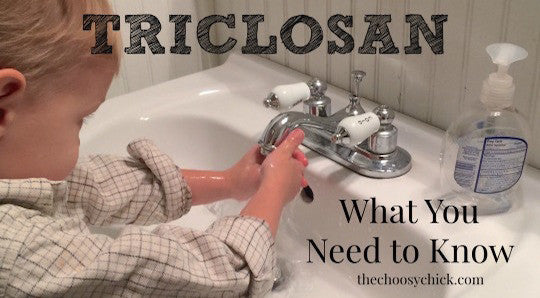With cold and flu season upon us, our Big Baddie Ingredient focus is

In September 2016, the FDA announced a ban on Triclosan. Triclosan (and related ingredient Triclocarban) is an antibacterial agent widely used in soaps, hand washes, toothpastes, personal care, toys, furniture and other consumer products. The EWG had been pressing the FDA for years to get rid of Triclosan. According to the FDA, the ban includes 18 other antibacterial related ingredients in antiseptic wash products and came about when companies were not able to provide evidence of the safety and effectiveness of these ingredients. Before we all go out and celebrate, recognize that this ban has its limitations.
THE PROBLEMS WITH TRICLOSAN:
Triclosan causes endocrine disruption, allergies, organ system toxicity and skin irritation. Because of its widespread use, it is found in urine and breastmilk and can be passed to babies in utero. It may also lead to antibiotic resistance. According to the Pub Med Database National Institutes of Health (NIH), Triclosan is known as a xenoestrogen (estrogen mimicking compound) and recent research shows it may play a role in the development of cancer. Environmental impacts include contamination of waterways resulting in a negative impact on fragile aquatic ecosystems. It is highly toxic to algae and may cause reproductive and developmental effects in fish. Triclosan was found in the sediment on the bottom of the Great Lakes. These health and environmental concerns inspired Minnesota to ban it in wash products effective January 2017.
THREE THINGS TO KNOW ABOUT THE FDA BAN:
1. PRODUCTS INVOLVED It is important to note that the FDA ban is restricted to wash products that are used with water and rinsed off - specifically antibacterial hand soaps. Triclosan is still permitted in toothpastes and consumer products, including plastics claiming to have "germ-killing" properties. We even have seen this claim on school pencils and office stampers.
2. SCARY SUBSTITUTIONS The FDA gave companies one year to get triclosan-containing hand soaps off the market, and banned 18 other antibacterial ingredients in soaps. Some manufacturers have already started removing these ingredients from their products, and concerns are being raised over their substitutions. Some are now turning to benzalkonium chloride, benzethonium chloride and chloroxylenol which the FDA will allow for ANOTHER year until adequate data regarding the safety and effectiveness of these ingredients is provided.
3. PLAIN SOAP AND WATER IS BEST There is a public opinion that we need to be using germ-killing ingredients to prevent the spread of illness. The FDA now recommends that washing with plain soap and warm water is best to prevent germ spreading. When on the go, and in need of a sanitizer, the CDC recommends using an alcohol based sanitizer.
This is another important reason to READ labels and understand the ingredients. Avoid products with antibacterial claims. While the ban in hand soaps is a small step in the right direction, why has it taken so long and why not ban it in ALL PRODUCTS?!
OUR RECOMMENDED ALTERNATIVES:
Sources:
- Antibacterial Soap? You Can Skip It: http://www.fda.gov/ForConsumers/ConsumerUpdates/ucm378393.htm
- The Big Baddies: The Choosy Chick http://thechoosychick.com/pages/the-big-baddies
- The EWG: http://www.ewg.org/research/ewgs-guide-triclosan
- NIH: Recent Evidence Regarding Triclosan and Cancer https://www.ncbi.nlm.nih.gov/pmc/articles/PMC3945593/



